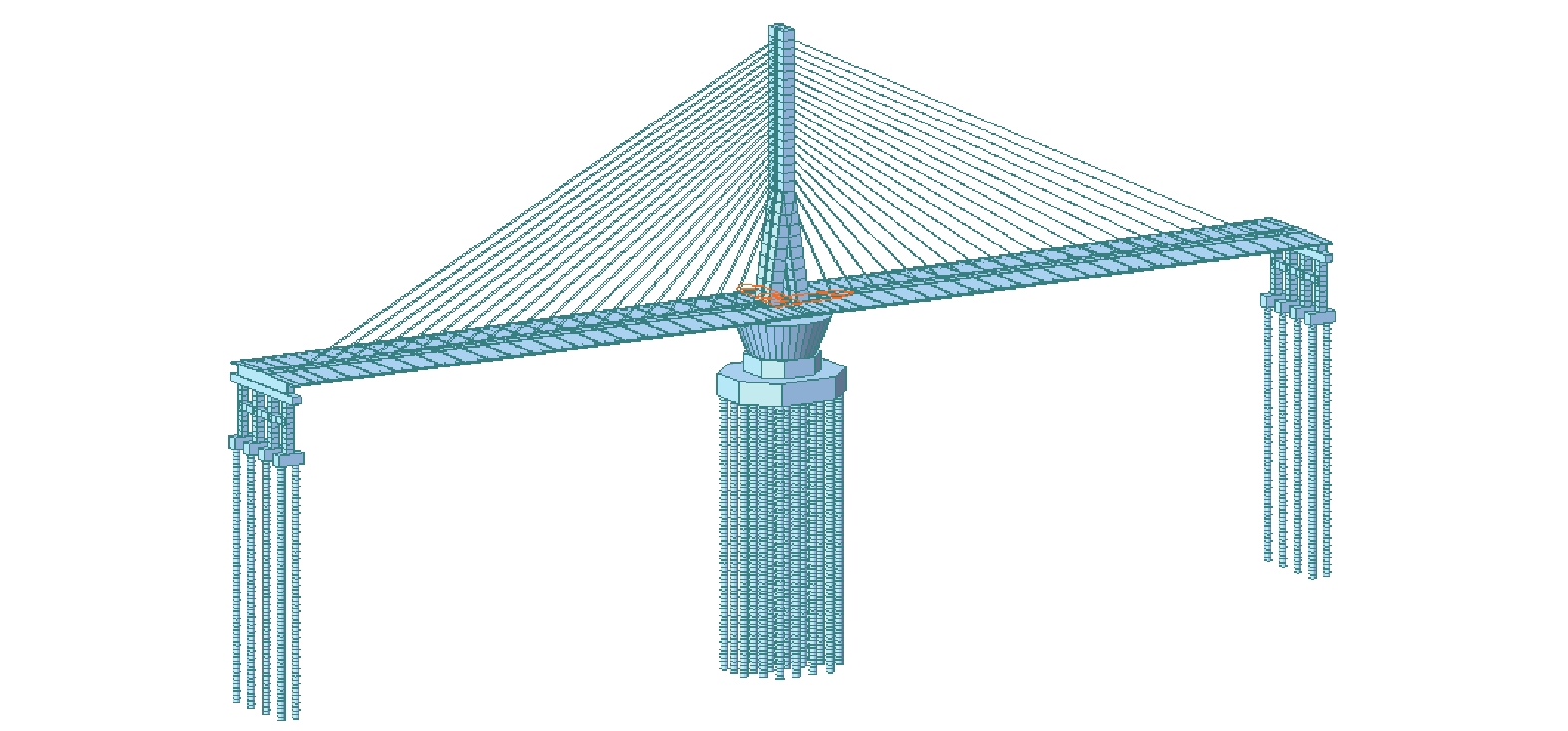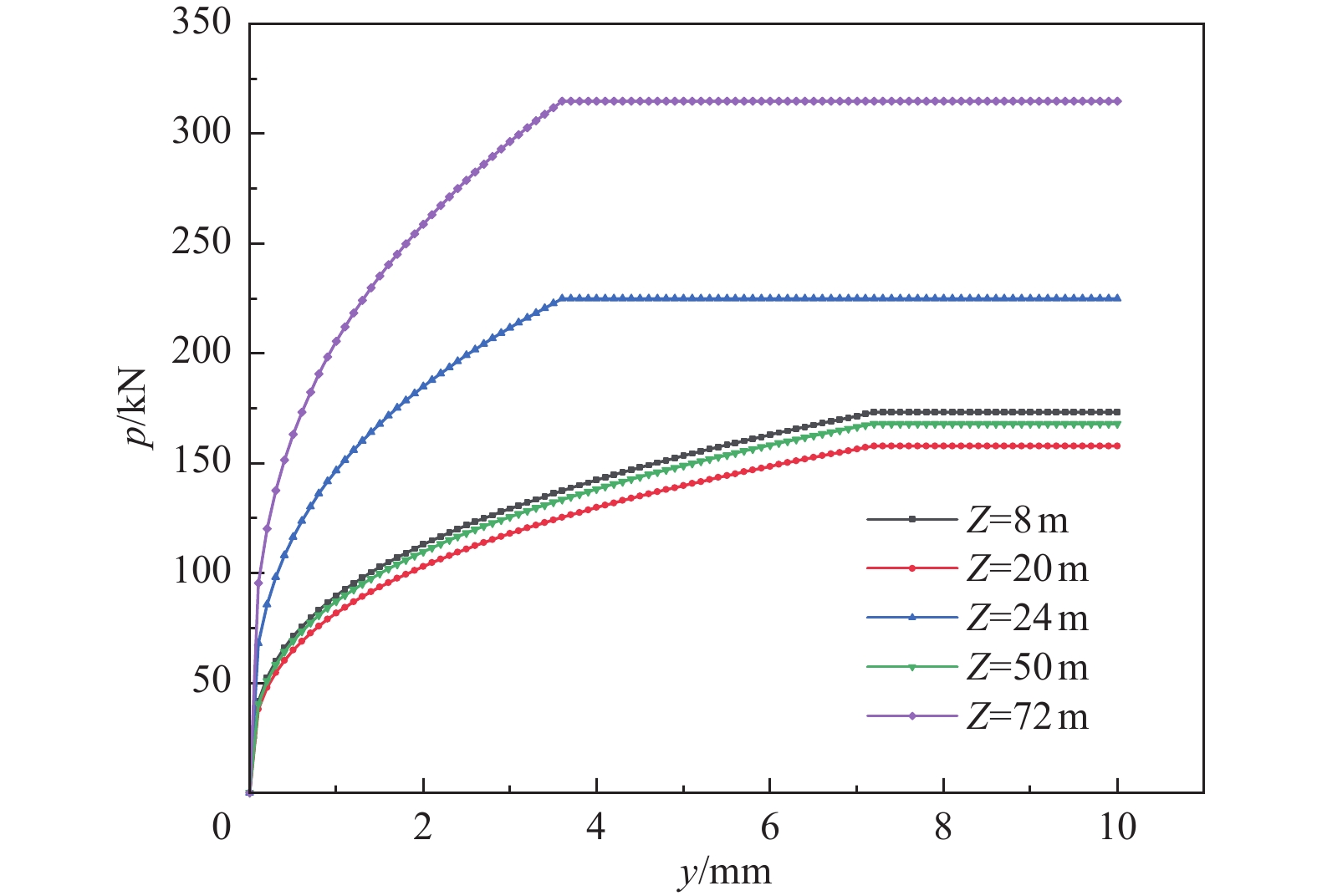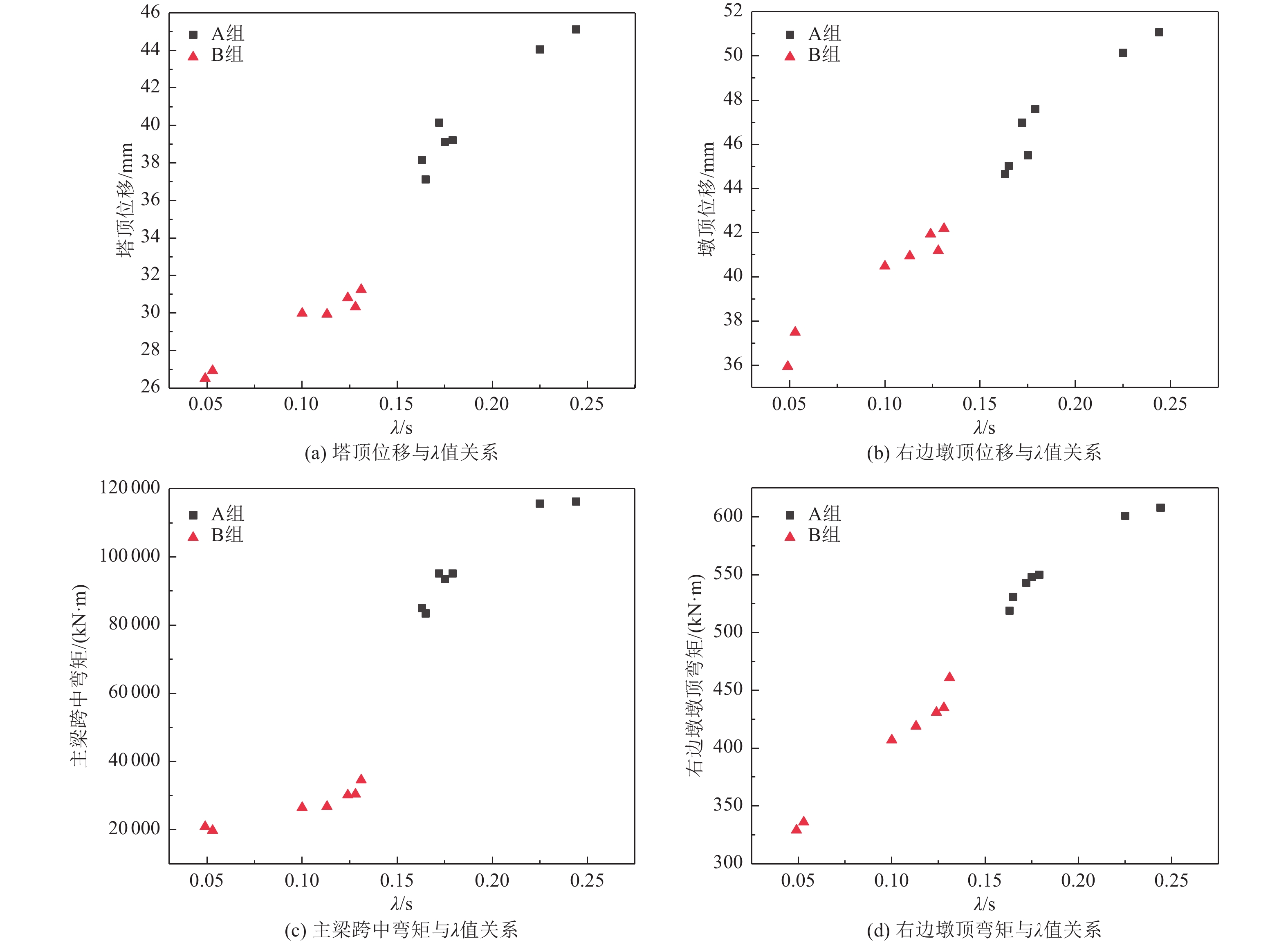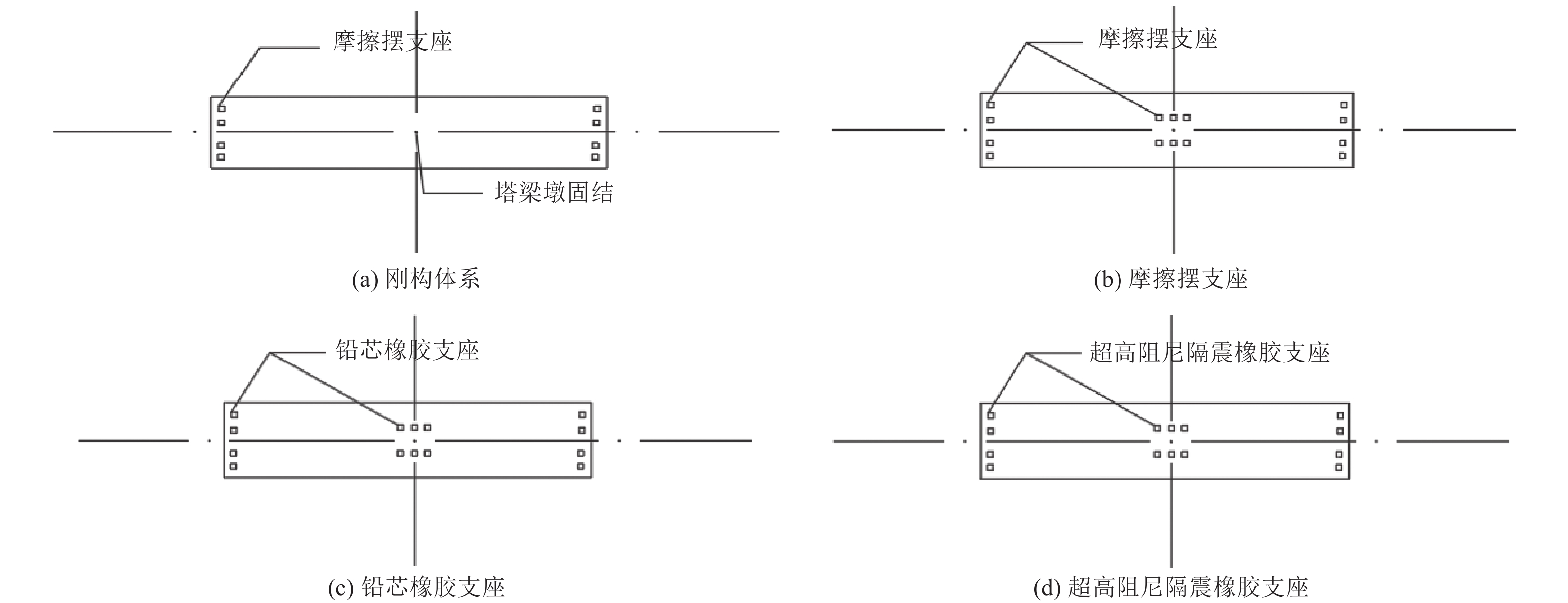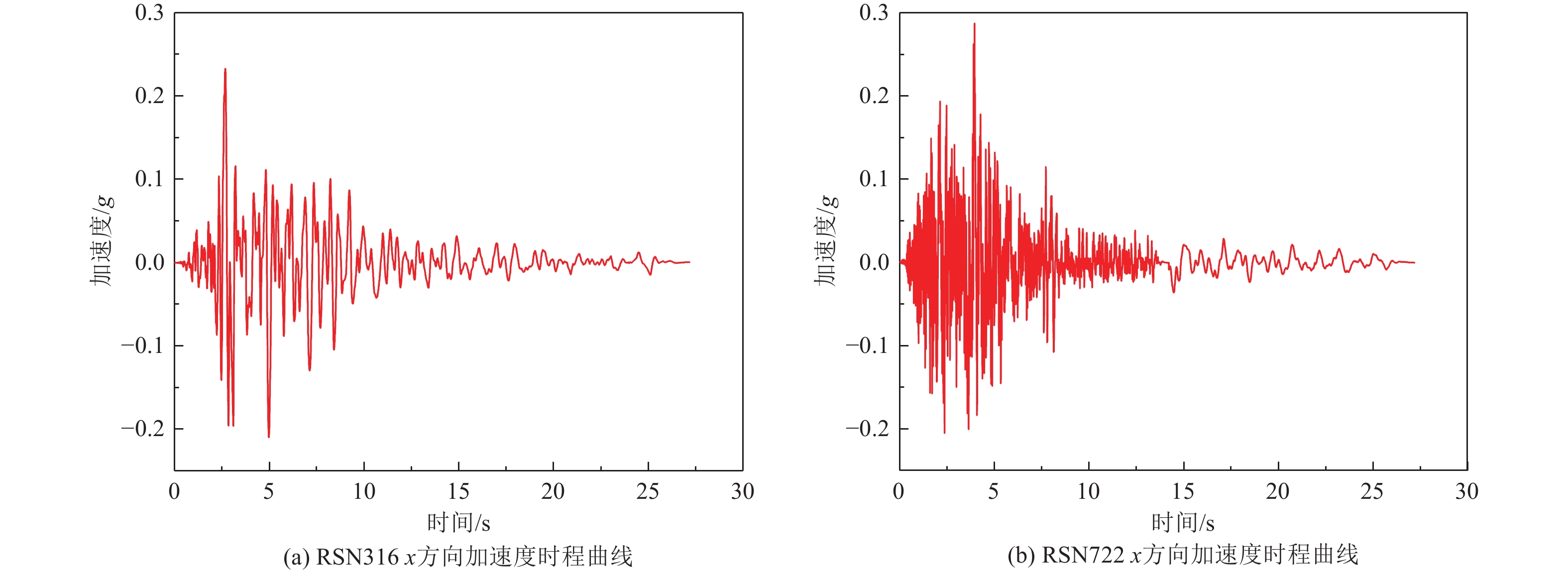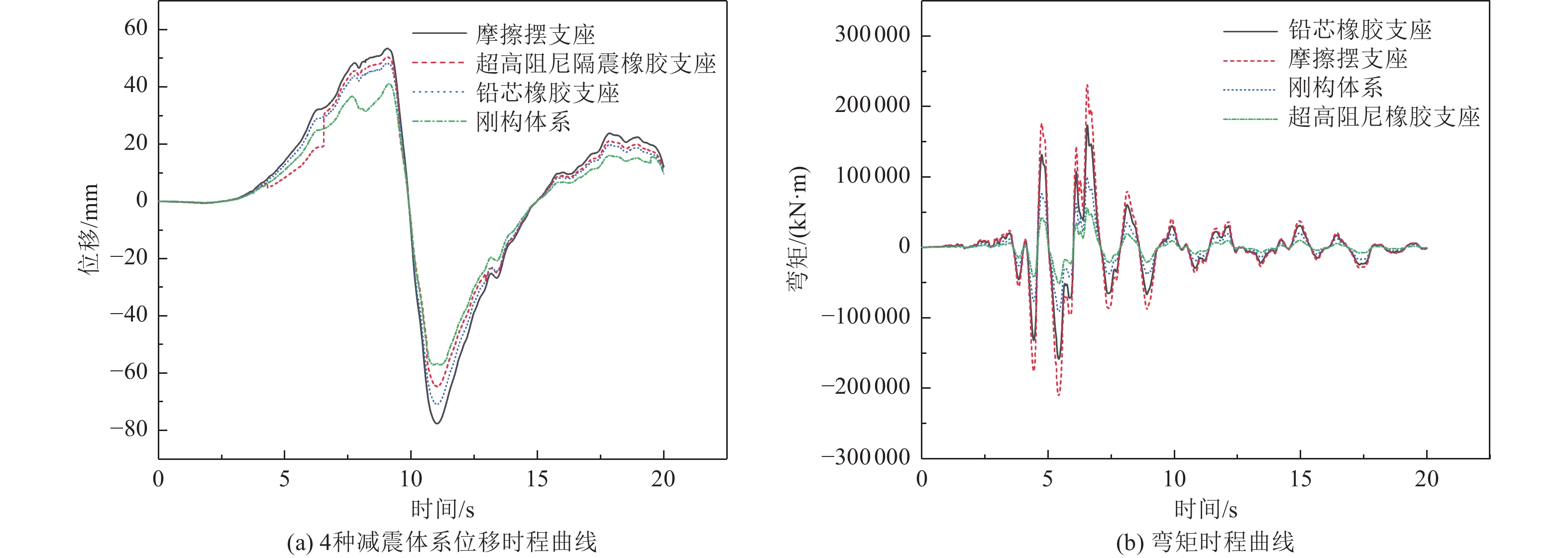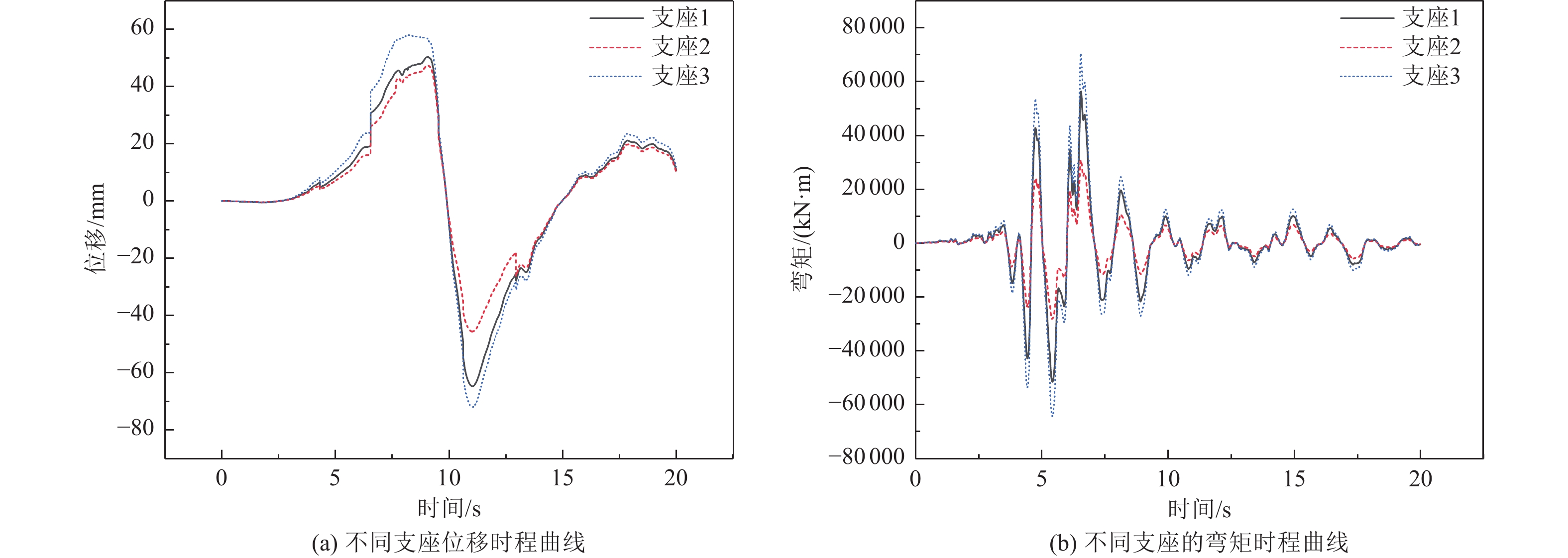Study on Isolation System of Single-tower Cable-stayed Bridge Under Soft Foundation Near Fault
-
摘要: 为研究近断层软弱地基下单塔斜拉桥的合理减震体系,以天津某单塔斜拉桥为工程背景,采用有限元软件建立动力分析模型,利用非线性动力时程分析法分析了近断层地震动地震响应及软弱地基条件下不同结构体系的地震响应。分别采用铅芯橡胶支座与超高阻尼隔震橡胶支座,通过改变支座参数,对比分析减震效果。结果表明,近断层软弱地基下,刚构体系相较于半漂浮体系,在主梁跨中位移减小7.37%,超高阻尼隔震橡胶支座的半漂浮体系相较于刚构体系在主梁跨中弯矩减小18.75%,效果最佳。支座的初始水平刚度会影响桥梁的整体刚度,使结构地震位移响应减小,因此当桥梁需要控制位移时,应选择初始水平刚度较大的支座。Abstract: To study the reasonable shock absorption system of a single tower cable-stayed bridge under soft foundation near faults, a dynamic analysis model of a single tower cable-stayed bridge in Tianjin was established by using finite element software in this study. The seismic response to ground motion near faults and the seismic response of different structural systems under soft foundation were analyzed by using nonlinear dynamic time history analysis method. Lead core rubber bearings and ultra-high damping rubber bearings are used respectively to change the parameters of the bearings and in order compare and analyze the damping effect. The results show that, compared with the semi-floating system, the displacement of the rigid frame system in the middle of the main beam span decreases by 7.37%, and the semi-floating system with ultra-high damping vibration isolation rubber bearing reduces the bending moment of the rigid frame system in the middle beam span by 18.75%. Our results suggest that the initial horizontal stiffness of the support will affect the overall stiffness of the bridge and reduce the seismic displacement response of the structure. Therefore, when the bridge needs to control displacement, the support with large initial horizontal stiffness should be selected.
-
表 1 各土层地质参数
Table 1. Geological parameters of each soil layer
土层序号 深度/m 土层厚度/m 土性描述 无侧限抗压强度qu/kPa 1 0~8 8.0 粉砂 38.5 2 8~20 12.0 粉质黏土 35.1 3 20~24 4.0 粉土 50.0 4 24~50 26.0 粉砂 38.1 5 50~72 22.0 粉质黏土 70.0 表 2 斜拉桥自振频率和振型特征
Table 2. Natural vibration frequency and mode characteristics of cable-stayed bridges
文献模型 本文模型 阶次 频率/Hz 振型 频率/Hz 振型 1 0.605 主梁竖弯+主塔纵弯 0.657 主梁竖弯+主塔纵弯 2 0.884 主梁竖弯 0.797 主梁竖弯 3 1.497 主塔纵弯 1.349 主塔纵弯 4 1.680 主塔横弯 1.640 主塔横弯 5 1.704 主梁横弯 1.694 主梁横弯 6 1.748 主塔横弯 1.717 主塔横弯 7 2.024 主梁竖弯+主塔纵弯 1.962 主梁竖弯+主塔纵弯 8 2.050 主梁竖弯 1.979 主梁竖弯 表 3 E2顺桥向作用下地震位移响应
Table 3. Seismic displacement response of E2 along the bridge
截面 Dx/mm Dy/mm Dz/mm 1-1 55.1 11.9 4.8 2-2 40.2 15.2 19.8 3-3 57.9 9.5 29.3 4-4 52.3 6.7 13.8 5-5 76.4 18.3 23.8 6-6 41.8 10.4 8.1 表 4 E2三向叠加振动作用下地震位移响应
Table 4. Seismic displacement response under E2 three-way superimposed vibration
截面 Dx/mm Dy/mm Dz/mm 1-1 64.0 14.5 5.2 2-2 44.4 19.3 23.0 3-3 65.8 12.5 31.0 4-4 75.1 8.3 14.4 5-5 98.0 21.0 24.3 6-6 47.0 14.3 8.2 表 5 E2三向叠加振动作用下地震内力响应
Table 5. Seismic internal force response under E2 three-way superimposed vibration
截面 轴力/kN 弯矩/(kN·m) 1-1 1.417×104 4.751×104 2-2 1.504×105 1.580×105 3-3 2.070×105 4.729×105 4-4 2.333×105 5.179×104 5-5 1.460×103 8.559×103 6-6 9.675×104 8.617×105 表 6 各土层
$ {\mathit{C}}_{\rm{u}} $ 、$ \mathit{\gamma } $ 取值Table 6.
$ {\mathit{C}}_{\rm{u}} $ 、$ \mathit{\gamma } $ values of each soil layer土层序号 深度/m 土层厚度/m 土性描述 $ {C}_{{\mathrm{u}}} $/kPa $ \gamma $/(kN·m−3) 1 0~8 8 粉砂 19.2 18 2 8~20 12 粉质黏土 17.5 19 3 20~24 4 粉土 25 18 4 24~50 26 粉砂 20 18 5 50~72 22 粉质黏土 35 19 表 7 各土层
$ \mathit{\rho } $ 、$ {\mathit{\varepsilon }}_{50} $ 取值Table 7.
$ \mathit{\rho } $ 、$ {\mathit{\varepsilon }}_{50} $ values of each soil layer土层序号 深度/m 土层厚度/m 土性描述 $ {\varepsilon }_{50} $ $ \rho $ 1 0~8 8 粉砂 0.02 2.5 2 8~20 12 粉质黏土 0.02 2.5 3 20~24 4 粉土 0.01 2.5 4 24~50 26 粉砂 0.02 2.5 5 50~72 22 粉质黏土 0.01 2.5 表 8 桩径或桩宽修正系数和土的压缩系数取值
Table 8. Pile diameter or pile width correction factor and compression coefficient of soil
土层序号 深度/m 土层厚度/m 土性描述 α/MPa−1 $ \zeta $ 1 0~8 8 粉砂 20 1 2 8~20 12 粉质黏土 18 1 3 20~24 4 粉土 17 1 4 24~50 26 粉砂 15 1 5 50~72 22 粉质黏土 8 1 表 9 结构内力响应
Table 9. Structural internal force response
截面 p-y曲线法弯矩/(kN·m) NL法弯矩/(kN·m) p-y曲线法轴力/kN NL法轴力/kN 1-1 2.65×104 2.90×104 8.19×103 1.18×104 2-2 8.15×104 8.70×104 1.26×105 1.50×105 3-3 1.69×105 1.97×105 1.99×105 2.19×105 4-4 2.39×105 2.50×105 1.94×105 2.13×105 5-5 0 0 1.34×103 1.47×103 6-6 4.16×104 4.79×104 1.24×105 1.50×105 表 10 结构位移响应
Table 10. Structural displacement response
截面 p-y曲线法位移/mm NL法位移/mm 1-1 17.3 19.0 2-2 19.1 20.3 3-3 38.7 42.6 4-4 14.1 15.0 5-5 25.0 27.0 6-6 13.3 14.0 表 11 A、B两组地震波断层距及PGV/PGA
Table 11. Fault distance and PGV/PGA of seismic wave groups A and B
分组 RSN 断层距/km $ \mathit{\lambda} $/s A 316 16.66 0.244 722 18.48 0.163 1013 5.92 0.179 1063 6.50 0.172 1086 5.30 0.225 1119 0.27 0.175 4847 11.94 0.165 B 8 44.68 0.051 20 27.02 0.131 52 173.16 0.049 122 33.40 0.100 138 28.79 0.128 166 50.10 0.113 280 76.26 0.124 注:RSN(Response Spectral Normalization)为每条地震波在peer数据库中的标号。 表 12 各支座参数取值
Table 12. Values of support parameters
支座型式 剪切弹性模量/MPa 支座屈服力/kN 初始水平刚度/(kN$ \cdot $mm-1) 等效阻尼比/% 超高阻尼隔震橡胶支座 0.8 941 27.9 20.0 摩擦摆支座 1.2 985 15.5 19.3 铅芯橡胶支座 1.0 1015 6.5 18.0 表 13 不同支座参数取值
Table 13. Values of different support parameters
支座型式 剪切弹性模量/MPa 支座屈服力/kN 初始水平刚度/(kN$ \cdot $mm-1) 等效阻尼比/% 支座1 0.8 941 27.9 20.0 支座2 0.8 877 31.4 20.0 支座3 0.8 877 18.8 20.0 -
陈笑宇,王东升,付建宇等,2021. 近断层地震动脉冲特性研究综述. 工程力学,38(8):1−14,54.Chen X. Y., Wang D. S., Fu J. Y., et al., 2021. State-of-the-art review on pulse characteristics of near-fault ground motions. Engineering Mechanics, 38(8): 1−14,54. (in Chinese) 陈扬,张铭,王秋良等,2022. 近断层脉冲型地震动作用下大跨斜拉桥的地震响应特征分析. 公路,67(1):97−104.Chen Y., Zhang M., Wang Q. L., et al., 2022. Analysis of seismic response characteristics of cable stayed bridges under near-fault pulse ground motion. Highway, 67(1): 97−104. (in Chinese) 贾俊峰,杜修力,韩强,2015. 近断层地震动特征及其对工程结构影响的研究进展. 建筑结构学报,36(1):1−12.Jia J. F., Du X. L., Han Q., 2015. A state-of-the-art review of near-fault earthquake ground motion characteristics and effects on engineering structures. Journal of Building Structures, 36(1): 1−12. (in Chinese) 蒋湘平,张鹏辉,王志平等,2024. 软土场地三塔斜拉桥纵向减震体系研究. 铁道标准设计,68(9):95−103.Jiang X. P., Zhang P. H., Wang Z. P., et al., 2024. Study on longitudinal seismic mitigation systems for three-tower cable-stayed bridges on soft soil sites. Railway Standard Design, 68(9): 95−103. (in Chinese) 焦驰宇,张家辉,胡彪等,2023. 基于动力p-y曲线法的曲线梁桥抗震性能研究. 地震工程与工程振动,43(2):93−102.Jiao C. Y., Zhang J. H., Hu B., et al., 2023. Research on seismic performance of curved girder bridge based on dynamic p-y curve method. Earthquake Engineering and Engineering Dynamics, 43(2): 93−102. (in Chinese) 李晓莉,石岩,王东升等,2019. 高烈度区临近断层桥梁的减隔震设计. 华中科技大学学报(自然科学版),47(1):73−78.Li X. L., Shi Y., Wang D. S., et al., 2019. Seismic isolated design for bridges near-faults in high seismic zones. Journal of Huazhong University of Science and Technology (Natural Science Edition), 47(1): 73−78. (in Chinese) 彭艳菊,唐荣余,吕悦军等,2004. 天津滨海场地土类别特征及其对地震动的影响. 地震工程与工程振动,24(2):46−52. doi: 10.3969/j.issn.1000-1301.2004.02.009Peng Y. J., Tang R. Y., Lv Y. J., et al., 2004. Tianjin seashore site classification and its effect on ground motion. Earthquake Engineering and Engineering Vibration, 24(2): 46−52. (in Chinese) doi: 10.3969/j.issn.1000-1301.2004.02.009 石岩,王东升,孙治国,2014. 近断层地震动下减隔震桥梁地震反应分析. 桥梁建设,44(3):19−24.Shi Y., Wang D. S., Sun Z. G., 2014. Analysis of seismic response of seismically mitigated and isolated bridge subjected to near-fault ground motion. Bridge Construction, 44(3): 19−24. (in Chinese) 石岩,王东升,韩建平等,2017. 桥梁减隔震技术的应用现状与发展趋势. 地震工程与工程振动,37(5):118−128.Shi Y., Wang D. S., Han J. P., et al., 2017. Application status of seismic isolation for bridges and its development tendency. Earthquake Engineering and Engineering Dynamics, 37(5): 118−128. (in Chinese) 王伟军,2022. 基于近断层地震响应的大跨矮塔斜拉桥动力优化. 兰州:兰州交通大学.Wang W. J., 2022. Dynamic optimization of long span extradosed cable-stayed bridge based on near-fault seismic responses. Lanzhou:Lanzhou Jiaotong University. (in Chinese) 谢俊举,吕承浩,李志恒等,2023. 2022年9月5日四川泸定MS6.8地震近断层地震动特征. 震灾防御技术,18(3):419−431.Xie J. J., Lv C. H., Li Z. H., et al., 2023. Characteristics of near-source strong ground motion observed from the September 5, 2022 Luding MS6.8 earthquake. Technology for Earthquake Disaster Prevention, 18(3): 419−431. (in Chinese) 徐龙军,彭龙强,谢礼立,2023. 地震断层形态研究综述. 世界地震工程,39(1):28−37.Xu L. J., Peng L. Q., Xie L. L., 2023. Review of rupture morphology of seismic faults. World Earthquake Engineering, 39(1): 28−37. (in Chinese) 尤洋,2018. 基于p-y曲线法的铁路桥梁桩基础抗震性能分析. 北京:北京交通大学.You Y., 2018. Seismic performance analysis of railway bridge piles based on p-y curve method. Beijing:Beijing Jiaotong University. (in Chinese) 张勇,2017. 桥梁结构设计中减隔震技术的应用. 公路交通科技(应用技术版),13(5):263−265. 张宇,2015. 考虑土−结构动力相互作用的独塔斜拉桥地震响应. 成都:西南交通大学.Zhang Y., 2015. Seismic response of a single-tower cable-stayed bridge with dynamic soil-structure interaction. Chengdu:Southwest Jiaotong University. (in Chinese) 赵畅,2022. 软弱地基上基础隔震结构动力学特征及其性能研究. 南昌:华东交通大学.Zhao C., 2022. Study on dynamic characteristics and performance of base isolated structure on soft ground. Nanchang:East China Jiaotong University. (in Chinese) 赵兴德,2023. 近断层脉冲地震对结构影响分析与选波建议. 山西建筑,49(14):58−61.Zhao X. D., 2023. The influence of near fault velocity pulse seismic on structural response and suggestions for selecting PGV/PGA values. Shanxi Architecture, 49(14): 58−61. (in Chinese) 宗周红,林元铮,林津等,2023. 跨断层地震动及其对桥梁结构影响研究进展. 中国公路学报,36(1):80−96.Zong Z. H., Lin Y. Z., Lin J., et al., 2023. Research advances of across-fault ground motions and their effects on bridge structures. China Journal of Highway and Transport, 36(1): 80−96. (in Chinese) -



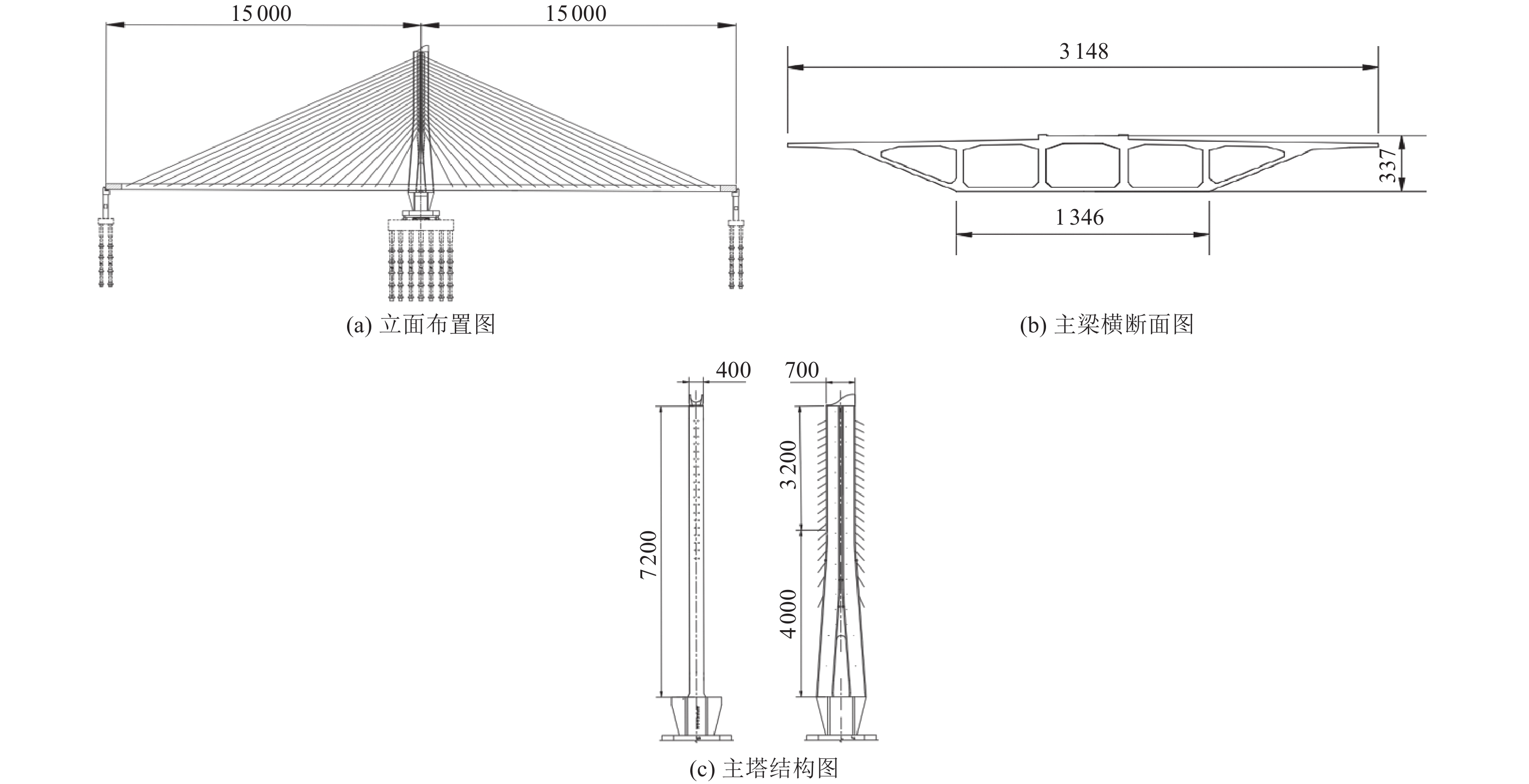
 下载:
下载:
